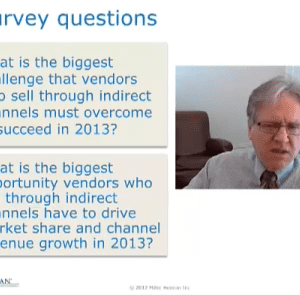Featured Posts
SiriusDecisions Aligns New Demand Waterfall To The Channel

Visibility into partner behaviors and garnering insight into lead performance are common challenges channel-centric organizations face. During the 2013 SiriusDecisions Summit, Laz Gonzalez, Service Director of Channel Management Strategies, and Matthew Papertsian, Research Director at SiriusDecisions, discussed how organizations can apply the rearchitected Demand Waterfall to the channel. The annual event took place May 8-10 in San Diego, Calif.
Many suppliers still are lacking insight into critical areas of partner businesses, which can significantly impact overall channel lead performance. The session, titled: The Rearchitected Waterfall in the Channel, offered insights into how the waterfall can improve channel lead development and results. In addition, the session provided a variety of problems many suppliers face in managing their channel networks, and how the new waterfall can provide solutions to these issues.
The most common obstacles standing in the way of channel marketers include:
- Lack of partner marketing skills;
- Lack of adoption of lead management processes;
- Poor lead quality and volume; and
- Poor visibility.
Gonzalez and Papertsian spotlighted four scenarios that many suppliers face daily:
1. What if partners lack skills to drive leads? Overall, many partners and resellers do not have the time or resources to execute advanced marketing campaigns and inbound strategies. As a result, suppliers are forced to rely on one-dimensional marketing that focuses more on outbound tactics. This goes against the wants and needs of today’s savvy buyers who are seeking integrated, multi-touch interactions.
The Solution: Suppliers should develop inbound programs to help partners generate net-new leads, Papertsian and Gonzalez advised. Then, organizations should guide partners through each step using a menu of plays based on MDF funds provided via their respective channel programs.
2. What if partners don’t follow lead processes? A major challenge for suppliers is ensuring partners adopt and adhere to lead management processes. If partners do not comply, possible issues include: poor/no lead follow-up; lead squatting/aging and a lack of deal registration, which has a severe impact on whether channel conflict occurs.
The Solution: Organizations can establish Service-Level Agreements (SLAs) to drive efficiency and consistency in the end-to-end channel demand creation process.
3. What if lead volume and quality are low? Suppliers’ inability to provide efficient and consistent lead generation and pass-off to partners sends a poor message, Gonzalez explained. He noted that these lackluster processes confirm that “garbage is on the way.”
The Solution: Develop a lead nurture process so leads are not passed to, or passed back to, channel sales until they have reached a lead threshold.
4. What if there is poor visibility into partner demand? Suppliers often struggle to obtain and maintain insight into partner activity, lead productivity and marketing and sales effectiveness. This lack of visibility typically is caused by no/poor reporting processes, channel conflict, and a lack of system integration.
The Solution: Suppliers should take a partner-centric approach when encouraging channel players to update leads. For example, organizations should make it easy for partners to register leads with a common format. Email typically works best for this, Gonzalez explained. Teleservices also can be utilized to manage and update progress, and set a regular cadence for sending and receiving updates.
SiriusDecisions Spotlights Cutting-Edge Partner Programs
During the Summit, SiriusDecisions also recognized top channel programs of the year. The team reviewed more than 80 channel programs, and selected four that “exceed industry standards.”
Gonzalez and Maria Chien, Research Director of Channel Management Strategies for SiriusDecisions, explained the threshold for these industry standards. Best-in-class programs, they noted, are similar to “perfect dates.” Both parties have common interests, lasting relationships and mutual commitments.
The winners included:
PrimePay: The payroll and business services company expanded its channel ecosystem by implementing the SiriusDecisions Channel Recruitment Waterfall. By taking a holistic approach and nurturing partners to sell and market effectively, PrimePay was able to increase partner recruitment by 49%. In addition, the company was able to boost pipeline in the financial services industry by 162%.
Progress Software: The application development, SaaS enablement and cloud deployment supplier wanted to address partner skill gaps and increase adoption of marketing initiatives. To do so, Progress Software considered the entire partner experience and aligned it with the buyer journey. With its Learn and Earn program, the company successfully helped partners understand new marketing strategies and educate them on how to leverage specific tactics based on positioning in the researching, consideration and buying process. Overall, Progress Software was able to fill critical partner skill gaps and increase marketing program adoption. Overall, partner adoption of the learning programs increased 100%.
SAP: The provider of business management software, solutions and services implemented a scalable channel demand creation program, leading to measurable outcomes. Through its Virtual Agency, SAP takes a self-service approach to marketing, offering partners access to prescriptive campaigns and partner-ready plays in 10 languages. SAP is generating awareness of the program through supplier-to-partner social enablement tactics, including a blog, podcast, YouTube, and is generating dialogue with partners using Twitter and other social networks. Overall, SAP improved VAR enrollment by 48% and experienced an 85% lift in VAR activity.
Adobe: To drive partner success for its Creative Suite, Adobe leveraged historical data to show channel partners new and unique sales opportunities based on which organizations had the highest propensity to buy. In addition, the company developed talk tracks that sales reps could use to have more meaningful conversations with existing customers, leading to new upgrade opportunities. Pay-for-performance rebate and MDF was included to provide partners with an extra incentive to perform. Overall, the program supported the launch of Adobe’s latest Creative Suite through high-impact channels, and generated $32 million in incremental revenue during a 24-month cycle just for North America.














